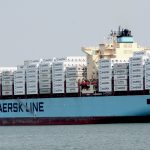COVID-19 Did Not Cause These High Freight Rates

Over the last year, Universal Cargo has posted so many blogs about the astronomical freight rates the international shipping industry has been seeing, shippers are probably tired of reading about it. Of course, shippers are even more tired of paying these rates that have set record after record over the last year, cutting deep into businesses’ profits. In previous years, we were able to post much more exciting blog posts with headlines about record low freight rates. What happened? How did freight rates get to this place?
Many will say it’s the pandemic. However, COVID-19 is not responsible for the high freight rates we’ve seen. Some might object and point to how freight rates have soared over the course of the pandemic. For those making that observation, it’s important to remember correlation does not mean causation.
COVID-19 has certainly played a role in the high freight rates shippers have been forced to deal with over the last year, but as the pandemic wanes, high freight rates are not likely to do the same. That’s because the root cause of these high freight rates is not the pandemic. The pandemic was merely a “tipping point” for the many factors that caused freight rates to get to where they are now.
Devin’s Seven Reasons for Spiked Freight Rates
The only person I know who’s probably as annoyed as me by the oversimplification of blaming the rise of freight rates we’ve seen over the last year on the pandemic is Devin Burke, Universal Cargo’s CEO.
“I just don’t want to put it out there that the Pandemic is the reason,” he told me. “It’s like maybe 20% of the reason, in my opinion.”
Years ago, Universal Cargo did a series of videos called Devin’s Sevens. Perhaps he can’t help himself from thinking in sevens because when Mr. Burke spoke about the reasons for these incredibly high freight rates, he gave seven factors:
- Reduction in vessel manufacturing due to the overcapacity glut between around ‘14-‘19
- Blank sailings
- Reduction in manufacturing of equipment
- Decommissioned vessels
- Very slow adaptation and progress of automation in US ports (compared to China and Asia) coupled with stubborn longshoreman unions keeping ports (especially LA) very slow, cumbersome, and congested
- China/US trade war ‘18-‘20 causing high tariffs
- Merging of carriers (giving them more unity and control of the market)
All of these factors are things I’ve written about in Universal Cargo’s blog, so regular readers aren’t likely to find these causes for high freight rates surprising. The lack of the pandemic showing up on Mr. Burke’s list, however, might be surprising. It’s important to know Mr. Burke is not dismissing the role the pandemic played in these high freight rates we’re seeing. Instead, he’s putting the pandemic’s role with freight rates in the proper context. These high freight rates are not happening in some pandemic bubble. They’re part of a continuum of what’s been happening in the international shipping industry.
“One of the key reasons the freight rates have spiked is because of what happened leading up to the pandemic,” Mr. Burke said. “I believe the pandemic was the lighting of the fuse (or the tipping point).”
This new Devin’s seven of factors listed above, he described as significant events in the international shipping industry that led up to March 2020.
What’s Really Happening
Some people will give you a simple narrative that the coronavirus pandemic came along and caused freight rates to spike like we’ve seen. While the pandemic played its role, that simple narrative is misleading and can distract from the things really happening in the international shipping industry. Many things have been happening for a long time that should have had shippers concerned before the pandemic ever struck.
All the factors Mr. Burke brought up are important. We’ve talked about them before in this blog and will go into more detail on them in the future. Regular readers of this blog know I’ve been warning about shrinking competition among carriers, with a combination of mergers, buyouts, bankruptcy, and especially consolidating into alliances for years.
In the year or two before the pandemic hit, we saw carriers tightening up on capacity, controlling how much space there was for shippers’ cargo on international waters. This was already allowing carriers to bring higher freight rates to the industry while limiting the volatility of falling then rising then falling again rates. Even without a pandemic, carriers were ready to push rates high. The pandemic, however, provided the perfect circumstances for carriers to flex their muscle. At the same time, the rest of the industry struggled under tight regulation and restrictions while being unprepared for the increase of demand that was about to hit, exacerbating the situation.
“So basically when the Pandemic hit and stopped everything for 3-4 months, then all of a sudden boomed because of pent up demand and the country opening up,” said Mr. Burke, “this gave carriers total control of market to make up for the billions they’d lost in the previous 8-10 years. So going forward, we will still see this trend, regardless of Covid, because there remains a shortage of vessel space, an increase in demand, shortage of equipment, slow ports, and carriers will take advantage of this to earn high revenues.”
All of this, we’ll get into more in future blogs. You can also search our blog for these key terms to see past posts pertaining to these issues.



